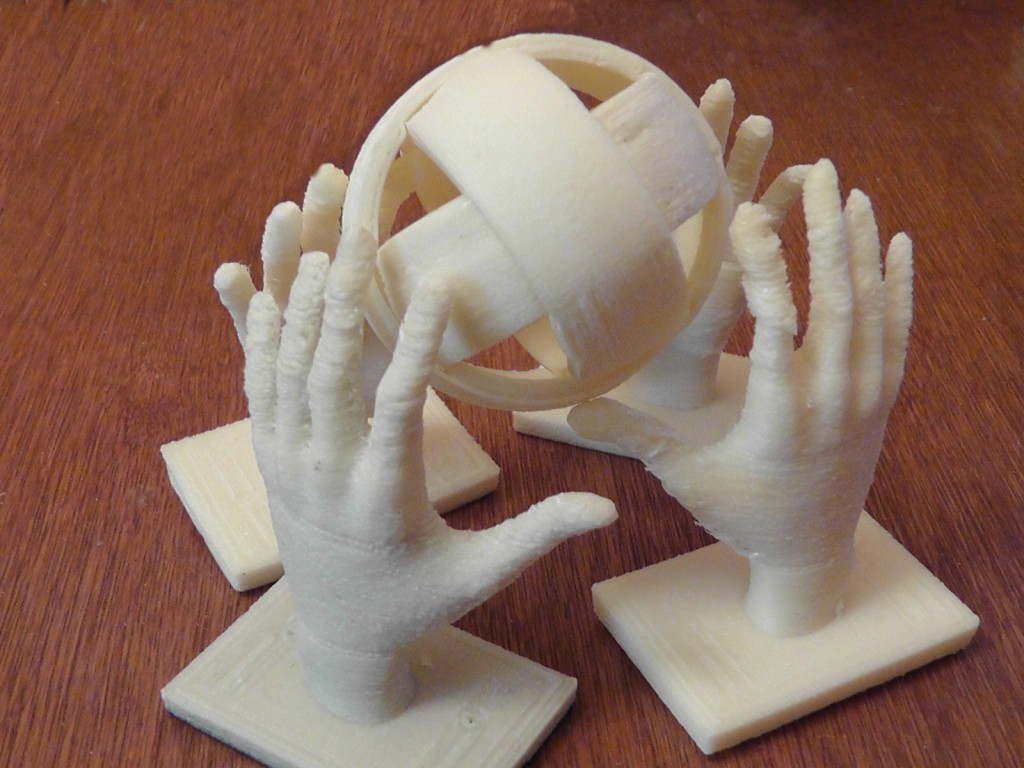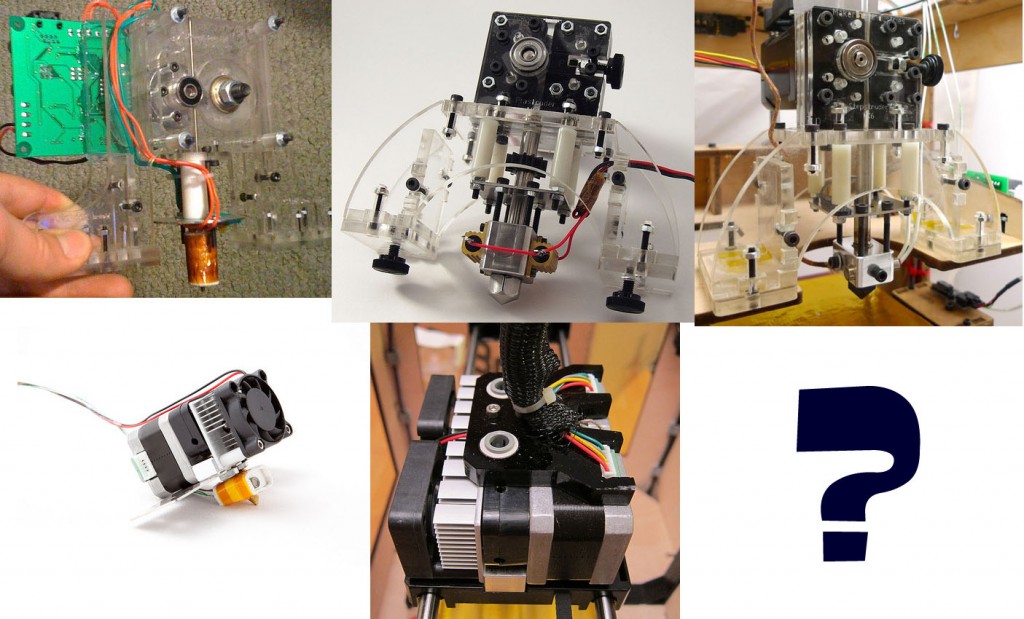Until recently 3D printing has been terribly expensive and only available to commercial design and manufacturing firms. A typical commercial 3D printer started at around $20,000. However, thanks to the Open Source community and the power of the World Wide Web, you can have Inexpensive 3D printers in your home for around $1000.
NEW EXTRUDERS
It is difficult to keep up with the ever-changing advances in this new technology. Advances in extruder head design and better heating element have drastically improved the print quality in a very short time. Makerbot has introduced two new generations of their products in 18 months. First Makerbot introduced the Replicator, a fully assembled, larger 3-D printer with the look and feel of the previous home built versions. The replicator offered dual plastic extruders and a larger work area. In September of 2012, Makerbot released the Replicator 2. The Replicator 2 is made of steel and will print large objects up to 11″x5″x5″ much faster than previous printers and at a higher resolution. Printer resolution has increased from .4mm to .1mm. This level of resolution makes the Replicator truely competitive with the more expensive commercial machines.
As 3D printer use becomes more common the quality of the printed parts have improved.Many printers now boast a layer height smaller than a piece of paper. A recent Kickstarter project raised well over a 1.2 million dollars in four days, for a portable stereo-lithography machine called the Form 1, which is said to have a resolution of 25 microns (.001″), or roughly the diameter of a human hair.
If the printing resolution continues to improve, perhaps one day we will be able to make electronic devices with printed circuits and wiring already in place. This idea is not so far-fetched. Members of the Reprap community have been experimenting with this idea already.
NOTHING NEW UNDER THE SUN
3D printing is not a new science. In fact 3D printing has been around since 1984. Chuck Hull invented a process called Stereolithography which focused a beam of ultraviolet light into a Vat of Photo-curable polymer to form a thin slice of plastic into a specific shape. The slice was then submerged in the plastic goop and the next layer was cured on top of the previous slice. By repeating this process a 3D shape was built up out of cured resin. Later, other 3D printing methods were developed including Fused deposition modeling (FDM), selective laser Sintering (SLS), Digital Light Processing (DLP) , Direct Metal Laser Sintering (DMLS), and High Definition 3D printing (HD3DP) also know as inkjet powder printing.
BUSINESS IS BOOMING
The home 3D printer market has begun to heat up. Many new players are introducing 3D printers. Each machine is just a little bit different and has unique features. However so far most of them use FDM to make the parts.
Here is a list of just a few, 3D printer companies.
- Makerbot industries http://makerbots.com
- Bits from Bytes (BFB) http://www.bitsfrombytes.com
- RepRap http://www.reprap.org/wiki/RepRap
- Botmill http://botmill.com
- FormLabs http://formlabs.com/
- Makergear http://www.makergear.com/products/3d-printers
- Ultimaker http://www.ultimaker.com/
3D MODELS
So how do you get the 3D models to use with your 3D printer? Many people draw their own 3D models using 3D CAD drawing packages. 3D drawing packages can be prohibitively expensive. Most popular 3D software cost between $1000 and $10,000, way beyond the means of most folks. However, there are now several low cost and several no cost options available. Here is a list of 3D software that is available for under $1000. The opinions expressed are those of the Author only.
- Alibre Design Personal edition costs $199 and is a parametric modeler capable of making very complex models and assemblies. I own the pro version $999. http://alibre.com
- Trimble Sketchup Pro costs $495 requires an STL export plugin to work. There is a Free version available.
- Blender is a freeware program that some people swear by. I found it difficult to use. http://blender.org
- Daz Studio is a 3D modeler and animation suite. $Free – $429.95. Plugin for STL export.
- 123D Autodesk’s free 3D modeler. This is a very nice program.
- Rhino 3D Also one of my favorites with lots of free tutorials $995 and worth it.
- Moment of Inspiration http://moi3d.com. Similar to Rhino 3D $295
You can also get free 3D objects from http://thingiverse.com. Thingiverse is a place where makers share 3D print files through open source. Thousands of designs have already been uploaded there. Thingiverse is really changing the way things are made.
HOW THINGS WERE MADE
The usual process to bring a plastic part to market was to design it in CAD. Next the CAD drawings were sent to a machine shop where they would make a mold along with the fixture which hold the mold in the injection molding machine while the part is being made. The the mold and fixture are sent to an injection molding plant and the parts are made in a batch and then tested. If there is something wrong with the part, it has to go through all those steps again and then be remade until you get it right. This can cost thousands of dollars and take many months to complete.
HOW THINGS ARE MADE NOW
The ability to replicate anything you can dream of is changing how things are made now. With a 3D printer you cut out a lot of steps. You do your design work in CAD and send the 3D file to Replicator G. From there you send it to the 3D printer. In a few minutes or hours your part is complete. You can even work on your next design changes while your part is printing. Then print a variation of your design almost immediately. No molds involved. Done.
The shorter design to production time difference can be staggering. I hope that this shift in product design will spur new rush of industrialism. When you have everyone able to compete with traditional design shops we should get some interesting new designs.
As the technology matures more types of materials will be available for printing. Already parts are being 3D printed in Aluminum, Titanium, sugar, glass, chocolate and more. Commercial 3D printers are now commonly printing in at least 17 different materials. Scientist have even successful printed living cells and are currently working on 3D printing Vaccines.
3D printers are a disruptive technology which will continue to have an impact on how people make things. Makers, Artisans, small businesses, tinkerers and inventors are rushing to embrace this technology. The next logical step will be for major industry to begin using the less expensive models in place of their current equipment.
WITH GREAT POWER COMES GREAT RESPONSIBILITY
With the increased use of 3D printers in the home also comes increased risks. Stratsys recently cancelled the lease on one of their 3D printers when they discovered that a man planned to print a 3D gun with it. The user planned to openly distribute the plans to print your own pistol through Open Source. Stratasys indicated that the reason for canceling the lease was because the user lacked appropriate firearms manufacturing permits and licensing. Current laws do not specifically deal with these issues yet but I am certain forensic technicians are breathing a sigh of relief.
Whenever a new technology is introduced there is a lag between governmental regulation and proper use guidelines. Early adopters of any technology should be conscious of there role in the responsible use of these new tools. I’m hoping responsible makers will obtained the proper permits prior to exercising their rights to bear arms digitally.




















[…] projectors. A recent Kickstarter.com campaign raised a million dollars in just a few days. The Form 1 Stereo Lithography product was so popular that the inventors decided to end the campaign early so […]
This product is new this year, but I haven’t seen anybody review it. The oneup ($199) and twoup ($279) 3D printers (http://store.quintessentialuniversalbuildingdevice.com/category.php?id_category=73).
I looked at the website and it looks like an interesting product. I would love to review one if they care to send one.